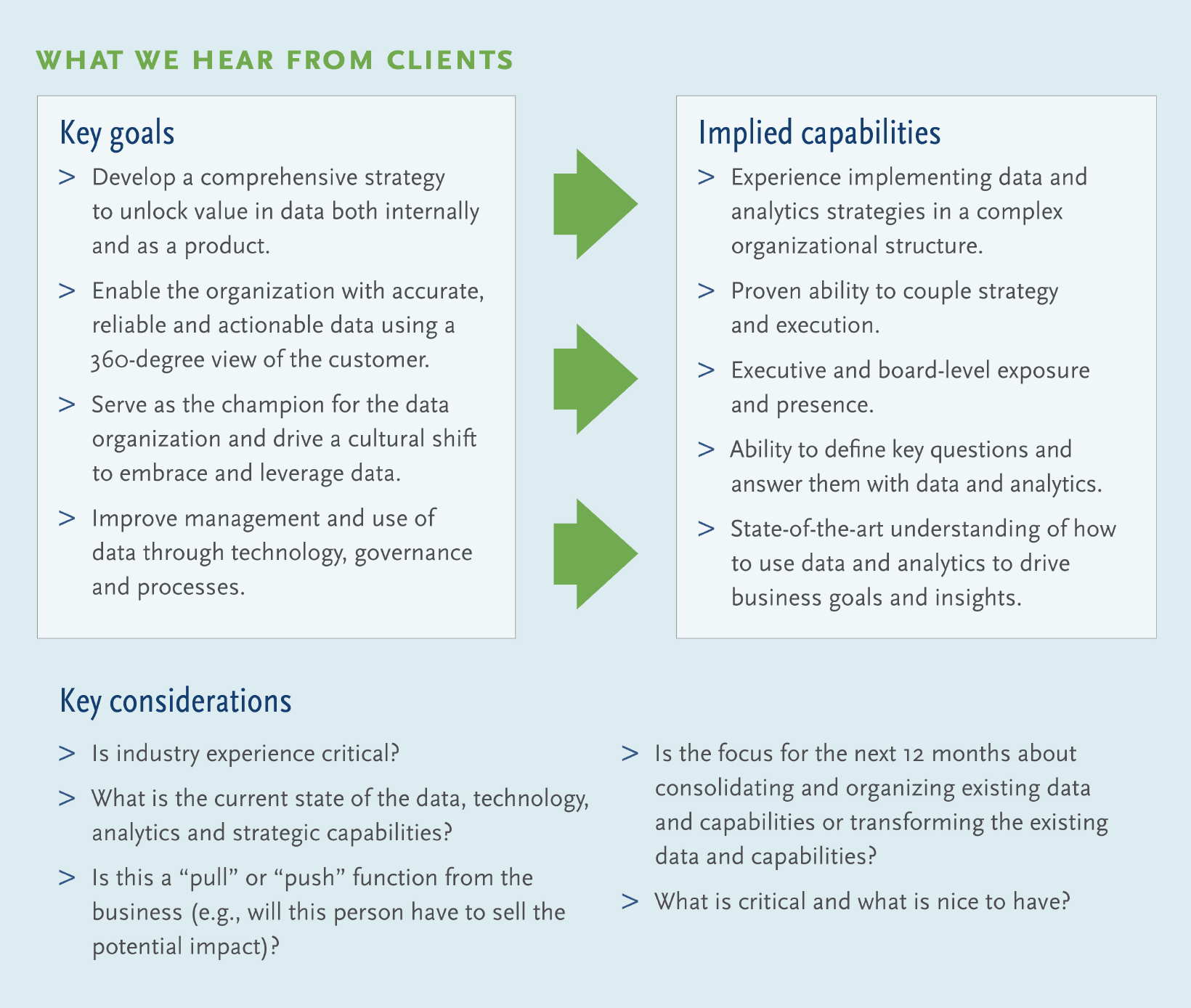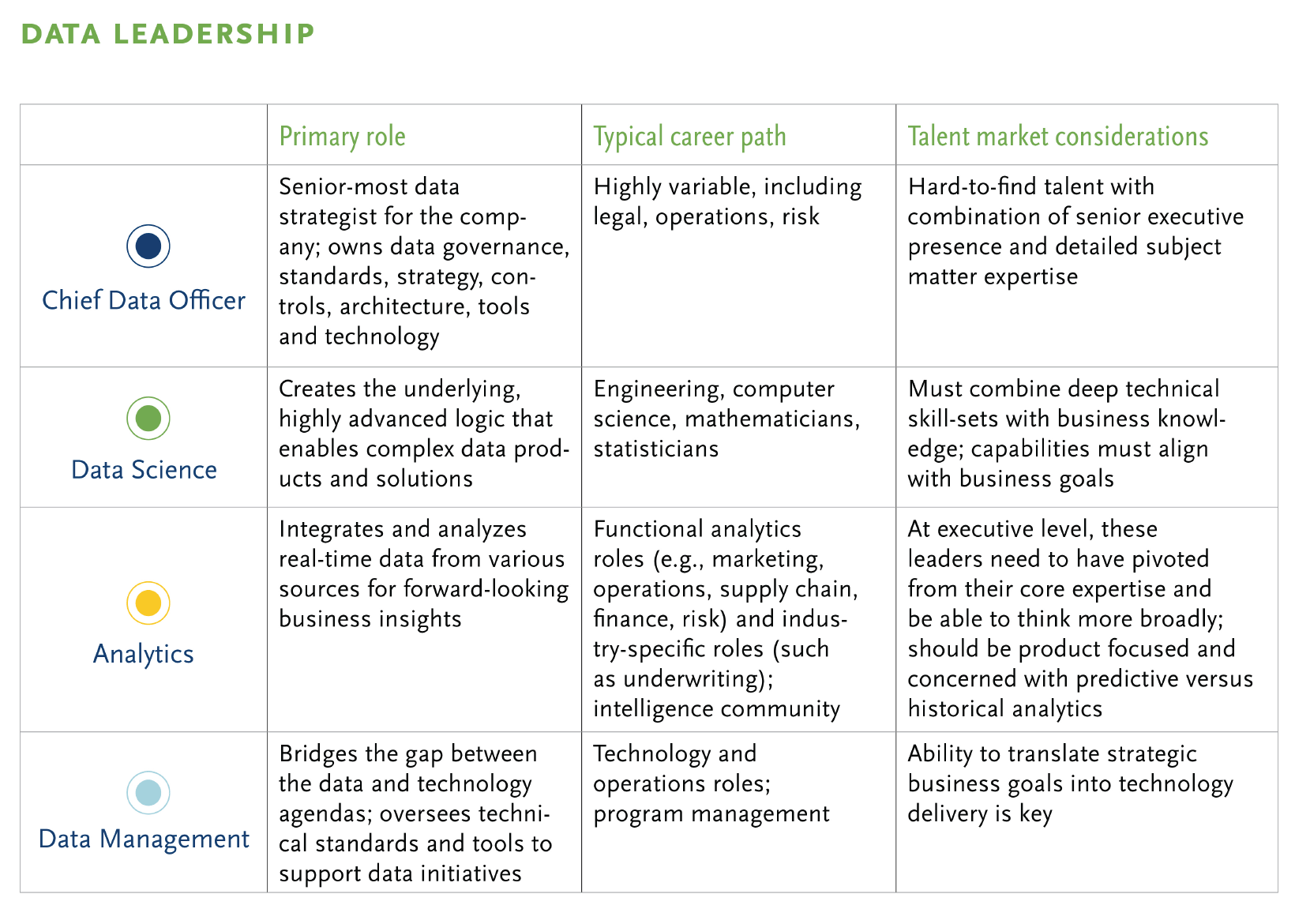The world of data and analytics is evolving at a pace
unseen in recent memory, with major talent implications
for organizations. Digital innovation is sweeping across
industries and creating opportunities for companies to
leverage data as a source of competitive advantage.
Given this tectonic shift, conversations in the C-suite and the
boardroom regarding data and analytics have also pivoted.
- Five years ago, it was “every man for himself,” with most organizations
still delegating data management to the IT organization, while analytics
lived separately in silos throughout the product, marketing, risk and
finance functions.
- Two to three years ago, the focus began to shift, as organizations
started taking a more centralized approach to data management and
analytics tools. The imperative moved to quality, consistency and
business intelligence.
- In today’s more mobile and digital world, leading businesses recognize
the value of data as an asset, and are leveraging new technologies and
business models to generate insights and deliver customer value, thereby
monetizing data in real time.
The term “big data” only scratches the surface of what’s possible with data and analytics for most organizations.
While it may be tempting to assume that appointing a chief data or analytics officer will solve every data problem
for the business, the reality is that most companies will need to assemble a leadership team with a variety of
nuanced skills and areas of focus in order to thrive in the new data-driven world. A recent McKinsey & Co. survey
revealed that, among lower-performing organizations, the most significant obstacle to achieving data effectiveness
is designing the right organizational structure. High-performing companies, meanwhile, have moved faster to
engage business leaders in data/analytics activities as the key to unlocking value. (“The Need to Lead in Data
and Analytics,” McKinsey, April 2016).
These survey results underscore the need to have highly engaging, evangelizing leaders driving your data agenda,
and also to be thoughtful about assembling a data team configured to serve your specific corporate agenda.
Through our work with many leading organizations, Spencer Stuart has observed that there is no one-size-fits-all
approach to hiring data and analytics executives. However, conversations with clients about their business priorities
and leadership needs reveal several consistent themes and considerations for recruiting senior data talent.

Defining the need: key data roles and responsibilities
Four primary leadership profiles have emerged within the senior-level data and analytics talent
pool, each with distinct responsibilities, backgrounds and market realities. When hiring senior
data talent, then, understanding your organization’s strategic opportunities and current capabilities
is an important first step in defining the specific leadership need — and an essential one for
the success of the role and data initiatives.
Chief Data Officer
Gartner predicts that more than 90 percent of large companies will have hired a chief data officer
(CDO) by 2019. But not all
CDO roles are created equal, and we find many organizations assigning the title without allocating
the resources or responsibilities necessary to make this person successful.
No matter how you choose to structure the role, by appointing a CDO, you are saying: “This
person is the senior-most data strategist and evangelist for our organization.” A true CDO
should chair an enterprise data council that includes key business owners, the CFO, risk and
legal, and establishes enterprise data policy and governance along with a consistent communications
plan and strategy. This leader should own responsibility for data governance, definition,
standards, strategy, controls, architecture, tools and technology, which are easily centralized.
At larger, more complex companies, the CDO must use influence and collaboration skills to
deliver business intelligence, third-party oversight, reporting capabilities and advanced analytics
for business use. When evaluating opportunities, effective CDOs are less concerned about
ownership of data initiatives than how they will add value to the business and whether they have
the sponsorship of key business leaders. They want to know, harkening back to the McKinsey
study, whether the business leaders are engaged, or removed from, the need to drive value
through data. The CDO frequently is focused on the business value of data and reports into
the CEO, leveraging the more technical skill-sets of data scientists, analysts and managers.
Data Science
Of all the talent markets within the data and analytics field, data scientists continue to be shrouded
in a bit of mystery. Traditionally called data engineers, mathematicians or statisticians, these highly
technical leaders create the underlying, highly advanced logic that enables many data solutions.
Organizations typically seek a head of data science as they look to drive complex data products
and solutions to the market, such as connected “smart” devices, and leverage predictive
analytics to create more profitable, consumer-aligned services. These executives work closely
with engineering and technology teams in the development of algorithms and the application
of artificial intelligence, machine learning and advanced predictive modeling and analytics. They
often report to the chief technology officer (CTO) or the head of product or marketing. The most
successful data science leaders are able to bring extreme currency in terms of technical skills along
with the ability to lead teams and help to set product strategies. They want to work on the most
advanced, cutting-edge projects and will be drawn to opportunities where their research lives
directly in the product.
Analytics
Organizations have been focused for years on analyzing data
to help drive business outcomes. From the emergence of
“business intelligence” a decade ago, analytics has evolved
rapidly across industries. No longer content to leverage
historical data to drive insights for the business, leading-edge
companies have embraced machine learning and sophisticated
data technologies, which serve as the backbone of true predictive
analytics. With this evolution, many who began their
careers in marketing analytics, operations and supply chain
research and financial analytics have evolved into true enterprise
analytics executives. The strongest analytics leaders
integrate real-time data from a variety of sources to both raise
the right questions and then find the answers in response rates
measured in milliseconds. With this sophistication has come
the rise of chief analytics officers and senior vice presidents
of analytics, many reporting to the CEO and often called to
engage directly with the board. The candidate pool for analytics
leaders tends to be the broadest and least technical.
Data Management
As the technology tools and capabilities supporting advanced
data acquisition, storage, mining, quality and analysis advance,
it is critical to have a technology leader who is focused on
maintaining the environment in which these capabilities will
live, architecting the data warehouse, establishing technical
standards and implementing tools. Your data management
leader is responsible for this essential “plumbing” of your data
infrastructure. Often this individual will report to both the chief
information officer and the chief data officer, helping to bridge
the gap between the data agenda and the technology agenda.
When they have a strong executive in this role, some organizations
are tempted to give them responsibility for their overall
data agenda. This is a mistake. Without a seat at the executive
committee, the data leader is unlikely to have the mandate,
influence or exposure to the business to advance
a real data agenda.

Conclusion
When venturing outside your organization to evaluate data leadership, especially for the
first time, a critical initial step for defining the expertise your company needs is to understand
the strategic opportunities and current capabilities of the business. Approaching
searches in this space flexibly and with an open mind toward discovering leaders who will
be able to unlock latent value in your enterprise tends to yield the best results.
Additionally, keep in mind that the best talent in this space is more transient and tends
to view employment differently than leaders in other disciplines. This can be OK. The
right data leader can add a great deal of value in several years, and may only be relevant
for part of your longer journey anyway.
View the journey toward data optimization as an ongoing, iterative process, during which
you will learn and make progress only by taking measured, manageable risks. The best
data-driven leaders already view the world this way and they will help you craft a more
nimble, agile business.